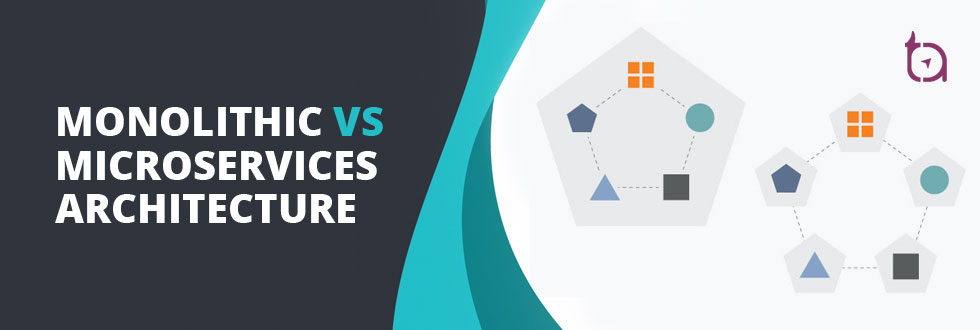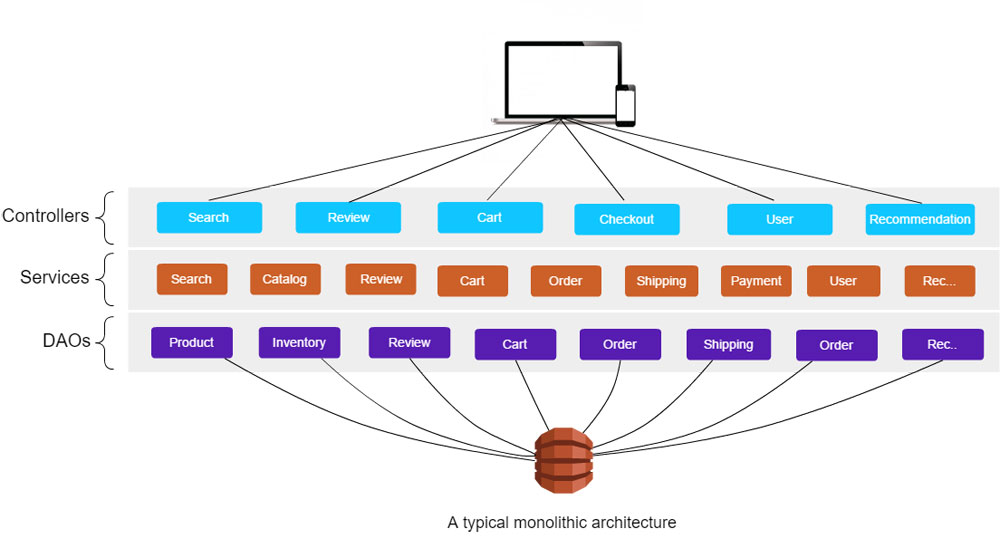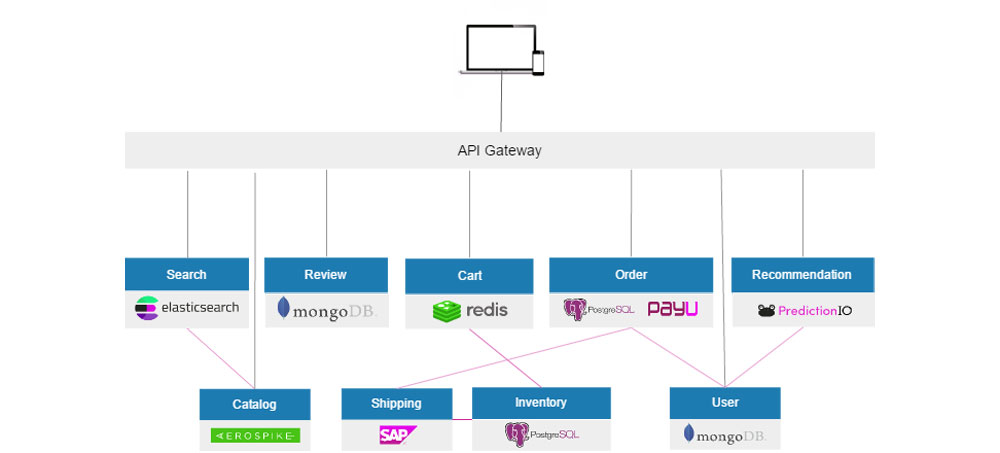Should you go with Monolithic Architecture or Microservices Architecture?

Author : John Prabhu 24th Dec 2020

Microservices architecture has become the center of attraction in building back-end systems. It doesn’t help only in implementing an organization’s IT functions but also contributes greatly to the digital transformation of an app business. Now, the architecture of microservices and monolithic have redefined the way IT teams are approaching the SDLCSDLCIn systems engineering, information systems and software engineering, the systems development life cycle, also referred to as the application development life-cycle, is a process for planning, creating, testing, and deploying an information system..
Wondering which architecture to choose between microservices and monolithic architecture? Well, before finding the one that suits your business, let’s look at some of the general goals to have an eye on while building your back-end system.
Distribute API Development
The system should have optimized endpoints, and it has to be designed in such a way that one or more teams can work on it parallelly. Therefore, a single team will not be subjected to overlooking the entire app to create optimized endpoints.
Support Multiple Languages
The functional parts of your app should support the preferred language of choice to take advantage of emerging technologies.
Minimize Latency
Your back-end architecture must be designed in such a way so that it reduces the client’s response time.
Minimize Deployment Risks
Your system should be capable of deploying each component separately with less or no coordination.
Minimize Hardware Footprint
Your system should be able to horizontally scalable and optimize hardware usage.
Building Monolithic Applications
When you plan to build an eCommerce app, you might go with platforms such as RoRRoRRuby on Rails (RoR) is a developer-friendly web application framework that provides you the tools to accomplish more with less code and have fun at the same time. RoR gives you wings when it comes to creativity and thereby lets you experiment and try out new things,Apache PlayApache PlayPlay Framework is an open-source web application framework which follows the model–view–controller architectural pattern. It is written in Scala and usable from other programming languages that are compiled to JVM Bytecode, e.g. Java. , Spring BootSpring BootSpring Boot provides basic and advanced concepts of Spring Framework, Spring Boot is a Spring module that provides the RAD (Rapid Application Development) feature to the Spring framework., etc. Hence, your app’s architecture would be as shown below:

The top layer (controllers) manages the client requests and forwards the requests upon certain validations to the service layer. In the service layer, all your business logics are implemented. The service will leverage various adapters such as messaging components, external APIAPIAn application program interface (API) is a set of routines, protocols, and tools for building software applications. Basically, an API specifies how software components should interact. Additionally, APIs are used when programming graphical user interface (GUI) components.s, database components in DAO layer, or other services in that layer. Thus, it prepares the result and returns it to the controller, which returns the same to the client.
When your app is packaged and deployed using the above-mentioned architecture, it will be termed as a monolith (one big file). This one big file will be a .jar.jarA JAR is a package file format typically used to aggregate many Java class files and associated metadata and resources into one file for distribution. JAR files are archive files that include a Java-specific manifest file. They are built on the ZIP format and typically have a .jar file extension. if you have used Spring Boot, and a zip file in case of RoRRoRRuby on Rails (RoR) is a developer-friendly web application framework that provides you the tools to accomplish more with less code and have fun at the same time. RoR gives you wings when it comes to creativity and thereby lets you experiment and try out new things or Node.jsNode.jsNode.js is a cross-platform runtime environment used to develop server-side and networking applications. It is an open source platform and the applications are developed using JavaScript. It can run within the Node.js runtime on Microsoft Windows, Linux, and OS X.. The advantages associated with apps built using this architecture are, they are easy to develop, test, comprehend, manage, and deploy.
Some of the serious limitations of monolithic architecture include the following:
Language/Framework Catch: You can’t use multiple languages to get the desired features for your app as you are locked down to using only one language and its related frameworks.
Difficult to Comprehend: It becomes hard for developers to comprehend the bulk codebase as the app developed is one large file.
Difficult to Distribute API Development: It is hard to follow agile development and a lot of developers’ time is wasted on one large file.
Deployment as a Single Unit: Since there are multiple dependencies, you can’t make even a minor change independently to a single component and deploy them.
Development Slow Down: While using monolithic architecture, it was very common to encounter apps having thousands of classes. This very fact is enough to slow down the IDE and startup times, which results in productivity lag.
Resources are not Optimized: There are two types of instances when it comes to image processing: compute-optimized instances and memory-optimized instance. While some modules use the former, some modules use the latter. At times, you have to compromise on the hardware choice as well. Also, one of your app’s modules might require scaling but you have to run the entire instance of the app again because you can’t scale a module separately.
To overcome all these hurdles, you can divide the components of your app into multiple smaller parts and manage them in such a way to run as a single application. That’s what microservices architecture does and let’s get to it.
Microservices Architecture:
Many of the leading organizations had overcome the disadvantages of monolithic architecture with microservices architecture. You can divide the application into smaller parts so that you can eradicate the larger services and enable smaller interconnected services. Each small part is capable of performing a task such as user management, order management, cart management, etc. Hence, you can write each service in any language/framework of your choice and can have polyglot persistence depending on your use case.
To make all your smaller parts act as one application, you have to hide all these services behind a new service layer and provide APIAPIAn application program interface (API) is a set of routines, protocols, and tools for building software applications. Basically, an API specifies how software components should interact. Additionally, APIs are used when programming graphical user interface (GUI) components.s that are tailored to each client. Else, the client has to face all the complexities such as maintaining several endpoints, aggregating the data from various services, separate authentication to each service, etc. The aggregator service layer is also known as API gateway and commonly used to resolve this issue.
Now, all the requests from the client go through this API gateway and then reach the appropriate microservices. The API gateway often handles a request with the help of multiple microservices and aggregate the results. Other responsibilities taken care by API gateway include load balancing, caching, monitoring, authentication, and static response handling. Since the gateway offers client-specific APIs, you can witness a decrease in the round-trips between the client and application that reduces network latency and also simplifies the client code.
In real-life situations, Amazon uses over 100 microservices to present a product page to its visitors; whereas, Netflix makes use of more than 600 microservices to manage their back-end. The below image shows an overview of how a scalable eCommerce app should be built and you must need further clarity while you want to implement while building your app.

Some of the complexities associated with microservices architecture are:
Distributed Computing Challenges: As each microservice needs to run in a distributed environment we need to take care of the associated challenges. In other words, the behavior and location of the components of the system will constantly change.
Remote Calls are Expensive: You need to implement an effective inter-process communication system.
Distributed Transactions: Your transactions that update several business entities have to rely on eventual consistency over ACID (atomicity, consistency, isolation, durability
Handling Service Unavailability: You need to build your system in such a way to handle unavailability or slowness of services.
All these complexities need not be handled manually. Instead, you can manage these complexities by automating them and building a self-healing distributed system that possess the following features:
Central Configuration: Changes made to a centralized and versioned configuration system such as Apache Zookeeper are dynamically applied to the running services.;
Service Discovery: You have to make sure every running service registers itself with a service discovery server and the server displays whichever service is online. You don’t have to hard-code service endpoint addresses into one another.
Load Balancing: Client-side load balancing helps you apply complex balancing strategies and perform caching, fault tolerance, service discovery, batching, and handle multiple protocols.
Inter-Process Communication: The inter-process communication can be built using RESTRESTRepresentational state transfer is a software architectural style that defines a set of constraints to be used for creating Web services. Web services that conform to the REST architectural style, called RESTful Web services, provide interoperability between computer systems on the Internet., Thrift or asynchronous, message-based communication mechanisms such as AMQP or STOMP. You can also take advantage of message formats such as Protocol Buffers or Avro as these won’t be used to communicate with the outside world.
Authentication and Security: You must have a system that identifies the requirements for authentication of each resource and reject requests that do not satisfy the requirements.
Non-Blocking IO: API Gateway handles several requests with the help of multiple back-end services and aggregating the results. There are certain requests like product details request, wherein the requests to back-end are independent of one another. The APIAPIAn application program interface (API) is a set of routines, protocols, and tools for building software applications. Basically, an API specifies how software components should interact. Additionally, APIs are used when programming graphical user interface (GUI) components. Gateway should perform independent requests concurrently to mitigate the response time.
Eventual Consistency: You will require a system that handles business transactions with multiple services. Whenever a service updates its database, it should publish an event and a Message Broker should be in place to ensure the event is delivered to the subscribing services at least once.
Fault Tolerance: Ensure your API Gateway handles failures easily and returns partial responses whenever possible. Also, you must ensure no fault should prolong and result in complete system failure.
Distributed Sessions: For the ideal functioning of your apps’ back-end, you should avoid having application states on servers. Instead, they should be saved on the client-side. You should always keep this in mind when you are using RESTful services. At times, you might come across situations where you can’t avoid this. During those situations, make sure your back-end has distributed sessions. It is so because the client communicates with the help of API Gateway and you have to run multiple copies of it behind a load balancer as you can’t afford to bottleneck the API Gateway. Also, you need to streamline the authentication process so that the client doesn’t have to re-authenticate every time at different instances of API Gateway.
Distributed Caching: You must implement effective caching mechanisms at multiple levels so that you can reduce client latency to a greater extent. Multiple levels are nothing but the client, API Gateway and microservices having caching mechanisms individually.
Detailed Monitoring: You should be able to monitor your back-end by tracking essential data and statistics of all the functional components for an accurate view of production. In addition, trigger alarms in case of exception or high response times.
Dynamic Routing: Build your API Gateway in such a way that the requests to microservices are effectively routed consistently even if it doesn’t have a specific mapping to the requested resource.
Auto Scaling: All the components of the architecture of microservices should scale horizontally and it should happen automatically even when deployed inside a container. This includes the APIAPIAn application program interface (API) is a set of routines, protocols, and tools for building software applications. Basically, an API specifies how software components should interact. Additionally, APIs are used when programming graphical user interface (GUI) components. Gateway as well.
Polyglot Support: Regardless of the languages/frameworks used to write the microservices, your system should be able to provide smooth service invocations and all the features discussed above.
Smooth Deployment: Ensure your microservices are fast, independent and can be automated if possible.
Platform Independent: With the help of docker, you can containerize your web services inside it and make efficient use of hardware. Thus, you can deploy platform-independent web services easily.
Log Aggregation: Ensure a log aggregating system is put in use to collect data effectively from the microservices to a system. Later, these can be used for analytics and optimizing purposes.
With the above features, you can make your back-end work seamlessly well and take effective care of your architecture. Based on your business requirements you can choose between these two. Most of the leading organizations follow microservices architecture as it allows them to be flexible and manage web services effectively.
Our expert developers have hands-on experience in developing scalable back-end systems for eCommerce stores, web portals, enterprise-grade web apps, and mobile apps, and more. Line up your queries to media@techaffinity.com or get in touch by scheduling a meeting with our developers.
